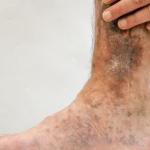
You’re sitting at dinner and you suddenly notice an area on your legs that looks similar to a bad bruise. You figure you must have bumped your leg on a chair or end table and forget it’s there. Over the next few weeks, the same spot has become darker and has now changed colors from a dark brown or purple to an even darker shade of blue or black. This change is skin color may start to look concerning, especially when it does not seem to get better or heal. For many people, skin discoloration is often disregarded as a bruise or age spot; however, did you know skin discoloration can be a sign of an underlying issue? If you have noticed any discoloration or changes to the skin of your legs and ankles, then you might have skin damage from vein disease.
Does Vein Disease Cause Skin Damage or Changes?
Skin Damage From Vein Disease
Venous insufficiency or vein disease occurs when veins have trouble sending blood from your limbs back to the heart, causing blood to collect in the legs or ankles. This condition can be caused by several different factors. it’s commonly caused by blood clots or untreated varicose veins. When blood is allowed to pool, inflammation can occur, causing swelling and skin changes.
It’s important to know what to look for and when to get treatment for discolored skin. Tracking the changes of discoloration or pain can help you understand when something isn’t healing or just getting worse. It’s easy to think wounds or skin discoloration will heal on their own. Unfortunately, they may progress to more serious health conditions.
What Are the Signs?
Some of the most common symptoms of vein disease are painful varicose or spider veins, leg pain, cramps, swelling, heavy feeling in the legs, restless leg syndrome, and skin discoloration. When the symptoms of vein disease are left untreated, the skin of the leg or ankle can become damaged and lead to more serious health conditions.
The symptom responsible for the skin discoloration is called hyperpigmentation. This can develop as blood leaks into the skin, and the iron in blood causes the skin to appear an unsightly brown or deep purple color. Hyperpigmentation may not be life threatening, but it can be a warning of ongoing severe skin damage.
Vein disease can also damage the skin’s texture, causing the skin to feel leathery, thick, and rough, a condition called lipodermatosclerosis. It’s also possible to develop another condition called corona plebectasia. This condition is described as a bluish discoloration of the ankles and feet due to blocked vein valves restricting blood flow.
The most serious form of skin damage caused by vein disease is venous ulcers. Venous ulcers commonly develop on the inside of the ankles or calves. They can occur when the skin opens or cracks into a sore. This is a result of the leaked blood surrounding the tissue in the legs, eventually causing it to break down.
These skin conditions are common in patients suffering from vein disease and varicose veins. Besides just looking unsightly, skin discoloration that is cause by vein disease can have a negative affect on your health if left untreated.
What to Do Now
Fortunately, there are several different treatment options for vein disease and varicose veins. It’s important you talk with a medical professional to determine the state of your condition and figure out which treatment will work best for you. If you have questions about symptoms caused by vein disease or poor circulation, contact us at 888.768.3467.
Don’t feel like calling? Explore our website to learn everything you need to know about underlying vein disease issues. Or click the button below to schedule your appointment with us today.
Related Articles
The Underlying Cause of Skin Discoloration
Dry, Scaly Skin? Don’t Be Too Quick to Blame the Weather





